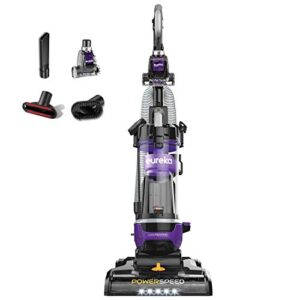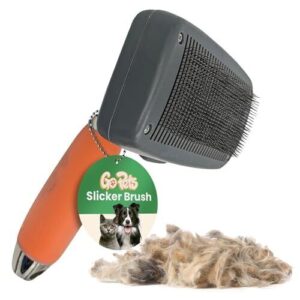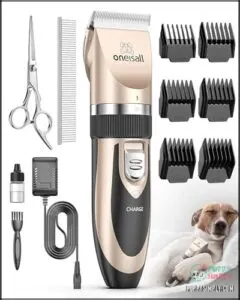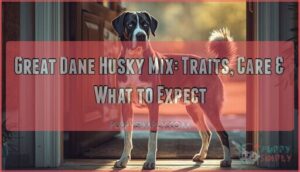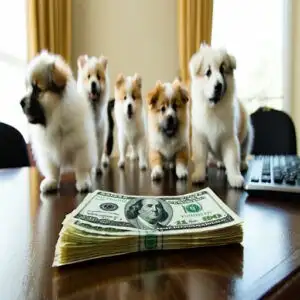This site is supported by our readers. We may earn a commission, at no cost to you, if you purchase through links.
Your eyes water. Your nose runs. That dog across the room—the one wagging its tail and begging for attention—might as well be wielding a box of tissues. About 10% of the U.S. population is allergic to dogs, but here’s what most people don’t realize: it’s not the fur that’s the problem. It’s the dander, saliva, and urine proteins that trigger those miserable symptoms.
The good news? Certain breeds produce markedly less of these allergens, making life with a four-legged companion entirely possible. From the iconic Poodle to the lesser-known Coton de Tulear, these dogs combine low-shedding coats with manageable dander levels. Pair the right breed with smart grooming habits, and you can finally stop choosing between your health and your dream of dog ownership.
Table Of Contents
- Key Takeaways
- Best Dog Breeds for Allergy Sufferers
- Key Traits of Hypoallergenic Dog Breeds
- Essential Grooming Tips for Allergy-Friendly Dogs
- Top Products for Managing Dog Allergens
- Choosing The Right Breed for Your Allergy Needs
- Frequently Asked Questions (FAQs)
- What are the best dogs for allergies?
- Are dog breeds hypoallergenic?
- Are hypoallergenic dogs good for allergies?
- Are there dog breeds that are less allergenic?
- What is the best dog breed for someone with allergies?
- What’s the most hypoallergenic dog?
- What is the lowest maintenance hypoallergenic dog?
- What is the best pet for someone who is allergic to dogs?
- Do all hypoallergenic breeds require special diets?
- How to introduce hypoallergenic dogs to kids?
- Conclusion
Key Takeaways
- It’s not the fur causing your allergies—dander, saliva, and urine proteins are the real culprits, which is why breeds like Poodles and Bichon Frises with low-shedding, curly coats trap allergens instead of spreading them around your home.
- No dog is truly hypoallergenic, but breeds that shed less dander and require consistent grooming (brushing 2-3 times weekly, bathing every 1-2 weeks) can reduce your symptoms by 30-60% when paired with HEPA filters and regular vacuuming.
- You need to meet the specific dog before committing—individual allergen production varies even within the same breed, so spending time with your potential companion and tracking your reactions is the only way to know if it’ll work.
- Smart grooming matters more than breed alone: professional trims every 6-8 weeks, daily brushing for long-haired breeds, and at-home dander control with the right vacuum and air purifier make allergy-friendly dog ownership actually sustainable.
Best Dog Breeds for Allergy Sufferers
If you’re dealing with allergies but still want a furry friend, you’re not alone—and you’ve got options. The right breed can make all the difference between constant sniffles and comfortable companionship.
Here are eleven breeds that tend to work well for people with sensitivities.
Poodle
The Poodle—available in standard, miniature, and toy sizes—stands out for its curly, low-shedding coat that traps dander instead of releasing it into your home. You’ll need consistent grooming techniques and professional trims every six to eight weeks. Their intelligence makes poodle training a breeze, and with proper canine nutrition and dog socialization, these hypoallergenic dog breeds adapt beautifully to allergy-friendly households. Regular health checks are essential to identify potential issues, utilizing scientific study methods for a more accurate diagnosis.
- Dense, curly coat requires regular brushing to prevent matting
- Low-shedding qualities make them ideal allergy-friendly dogs
- High trainability suits first-time and experienced owners alike
- Breed history as multipurpose companions enhances their appeal
- Prone to hip dysplasia and eye conditions—schedule routine vet checks
Bichon Frise
Like the Poodle, the Bichon Frise boasts a curly coat that traps dander before it floats around your home—perfect if you’re hunting for allergy-friendly pets.
Regular Bichon Training and dog socialization help channel their playful energy. You’ll want solid Frise Nutrition and consistent grooming every six to eight weeks.
Consider pet insurance, since these low-shedding dogs can face dental issues and joint concerns down the line.
Yorkshire Terrier
Yorkshire Terriers shed very little thanks to their silky, hair-like coat, making them popular among allergy-friendly pets. Daily brushing traps dander before it spreads, helping you manage dog allergies while enjoying one of the top low-shedding dogs in the hypoallergenic dog breeds lineup.
Regular Terrier Training and Dog Socialization keep these spunky Small Breeds well-mannered. Focus on Yorkie Nutrition—quality food promotes Pet Health and coat shine.
Maltese
Another low shedding dog for anyone managing dog allergies, the Maltese sports a long, silky coat that requires frequent brushing to remove loose hair and reduce Pet Dander Removal needs.
Daily grooming routines and quality Maltese Nutrition support Canine Skin Health, minimizing allergen buildup. Though hypoallergenic pets aren’t guaranteed, many people find this breed gentler on their symptoms—especially with consistent care.
Schnauzer (Miniature, Standard, Giant)
If you want a sturdy, low-shedding dog with personality to spare, the Schnauzer comes in three sizes—Miniature, Standard, and Giant—each sporting that signature wiry coat.
Regular grooming and brushing reduce dander buildup, while consistent Schnauzer training keeps these intelligent pups happy. Many allergy sufferers find this breed easier to live with, especially when paired with proper Miniature care and professional grooming every six to eight weeks.
Havanese
The Havanese brings a silky, low-shedding coat and a cheerful, people-loving temperament to allergy-friendly pets. This breed’s minimal shedding helps reduce allergen exposure, though Havanese training and consistent dog grooming—brushing several times weekly—are essential.
Factor in dog nutrition, pet insurance, and their companion-dog canine behavior when choosing hypoallergenic dog breeds. Understanding breed history reveals why these adaptable pups thrive with families seeking allergy-conscious companionship.
Irish Water Spaniel
The Irish Water Spaniel brings a distinctive curly coat and lively energy to allergy-friendly pets. This medium-sized breed’s dense, low-shedding fur helps manage dog allergies and asthma, though regular spaniel care—professional grooming every six to eight weeks—keeps dander in check.
Consider these breed essentials:
- Training needs: High intelligence requires structured, positive-reinforcement methods
- Exercise demands: Daily vigorous activity prevents behavioral issues
- Grooming routine: Consistent brushing reduces matting and allergen buildup
- Health monitoring: Watch for ear infections given their water-loving breed history
- Living situation: Best with active families who appreciate curly-coated, energetic companions
Basenji
The Basenji’s short, fine coat sheds minimally, making it one of the top low shedding dogs for allergy-friendly pets. This “barkless” breed from central Africa needs consistent Basenji training and daily exercise to channel its independent energy.
Regular brushing reduces dander, while early dog socialization fosters stable behavior. Monitor Basenji health for breed-specific conditions, and guarantee your home offers secure spaces for this curious, athletic companion.
Shih Tzu
The Shih Tzu sheds minimally thanks to its hair-type coat, but regular Shih Tzu grooming is essential for allergy management. Bathe your hypoallergenic dog every two to four weeks and brush daily to control dander.
Pair this routine with quality dog nutrition, veterinary care, and pet insurance for health screening. These allergy-friendly pets thrive in small spaces and make affectionate companions for households managing sensitivities.
Chinese Crested
Looking for a breed that barely sheds? The Chinese Crested is one of the most distinctive hypoallergenic dog breeds, available in both Hairless Variety and Powderpuff types. Here’s what makes these low-shedding dogs special for allergy-friendly pets:
- Minimal allergen exposure – The hairless option produces less dander than most dog breeds for allergies.
- Dual coat choices – Powderpuff grooming requires daily brushing, while hairless needs sun protection.
- Compact size – Weighing 9-12 pounds, they’re perfect for apartments.
Chinese Crested care includes monitoring for skin conditions and regular dental checkups.
Coton De Tulear
The Coton de Tulear brings a soft, cotton-like coat that sheds minimally, earning its spot among hypoallergenic breeds. Originating from Madagascar, this breed’s history includes centuries as a companion dog.
Tulear training is straightforward thanks to their eager-to-please nature. Coton care demands daily brushing to prevent matting, plus regular baths to control dander. Watch for health issues like hip dysplasia.
These low-shedding dogs adapt beautifully to apartment living.
Key Traits of Hypoallergenic Dog Breeds
You’ve seen the breeds, but what actually makes a dog “hypoallergenic”? Understanding these key traits helps you choose the right companion and manage your allergies effectively.
Let’s break down what separates allergy-friendly dogs from their shedding counterparts.
Low-shedding Vs. Non-shedding Coats
You’ve probably heard the terms ‘low-shedding’ and ‘non-shedding’ tossed around when researching hypoallergenic dog breeds. Here’s the truth: all dogs shed to some degree.
Low-shedding dogs release fewer loose hairs than breeds with double coats, while non-shedding varieties—usually single-coated breeds—shed minimally.
Neither coat type eliminates allergens completely, but both can markedly ease your symptoms with proper grooming needs and allergen management strategies.
Role of Dander in Allergies
Dander—those tiny skin flakes dogs shed—carries the real troublemakers: allergen proteins like Can f 1 and Can f 2. When your dog’s skin naturally renews itself, these microscopic particles become airborne and cling to your furniture and clothes. Here’s what matters:
- Dander floats in the air for hours
- It sticks to fabrics and surfaces
- Regular grooming reduces loose dander
- HEPA filters capture airborne particles
- Even hypoallergenic dogs produce some dander
No breed eliminates allergies completely, but smart dander removal helps.
Coat Texture and Maintenance
Your dog’s hair texture plays a big part in keeping allergens under control. Curly coats on Poodles and Bichon Frises trap shed hairs instead of releasing them into the air.
Wiry Schnauzer coats and long Shih Tzu fur need weekly brushing with slicker brushes to lift loose undercoat and skin cells. Bathe every four to eight weeks, and you’ll cut down airborne dander markedly.
Breed-specific Allergen Production
Each breed’s genetic makeup influences how much Can f 1 and Can f 2 protein they release in saliva and skin cells. Allergen testing reveals surprising differences:
- Poodles trap particles in dense curls, lowering airborne exposure
- Maltese produce moderate dander despite their small size
- Yorkshire Terriers release notable Can f 1 in close quarters
- Bichon Frises show higher dander content than expected
- Breed variability means individual dogs differ even within hypoallergenic breeds
Protein levels fluctuate with grooming, environment, and canine genetics.
Essential Grooming Tips for Allergy-Friendly Dogs
Even the most allergy-friendly dog won’t stay that way without the right care routine. Grooming isn’t just about keeping your pup looking sharp—it’s your best defense against dander buildup in your home.
Here’s what actually works to keep allergens under control.
Regular Brushing and Bathing
Think of brushing and bathing as your first line of defense against allergens. Regular brushing removes loose fur and dander before it scatters around your home, while weekly baths with pet-specific shampoo wash away surface allergens. You’ll want to adjust frequency based on your dog’s coat type and your sensitivity—consistency matters more than intensity for effective dander removal and skin health.
| Grooming Task | Frequency | Allergy Benefit |
|---|---|---|
| Brushing | 2-3 times weekly | Removes loose dander |
| Bathing | Every 1-2 weeks | Reduces surface allergens |
| Coat checks | During each brush | Prevents irritation |
Professional Grooming Benefits
A skilled groomer can tackle what you might miss at home. Professional grooming techniques offer deep coat maintenance that minimizes trapped allergens and promotes skin health in hypoallergenic dog breeds. Here’s what you gain:
- Thorough dander reduction through specialized brushes and high-velocity dryers
- Expert eye for early skin irritation or matting issues
- Consistent allergen minimization with scheduled appointments
- Better odor control for allergy-friendly dogs
- Professional-grade products designed for low-shedding dog breeds
Regular visits keep your pet care and grooming routine effective.
At-home Dander Reduction Methods
Between grooming sessions, you can slash airborne allergens with HEPA purifiers that cut dander by 30–60% in a day. Vacuum filters designed for pet hair trap particles standard models miss.
Swap heavy drapes for washable pet bedding to lower dander buildup by up to 50%. Regular brushing twice weekly removes 60% of loose fur before it scatters through your home.
Top Products for Managing Dog Allergens
Even with the right breed, you’ll need a few solid tools to keep allergens under control at home. The good news is that the right vacuum, air purifier, and grooming gear can make a real difference in how much dander floats around your space.
Here are four products that consistently help allergy sufferers live more comfortably with their dogs.
1. Eureka Lightweight Upright Vacuum Cleaner
When pet dander settles into your carpet, you need a vacuum that won’t just push allergens around. The Eureka Lightweight Upright Vacuum Cleaner uses sealed filtration to trap up to 99.97% of particles, including pet dander, making it a solid choice for allergy sufferers living with low-shedding dog breeds.
Its pet tool attachment targets hair on upholstery, and the 2.1-liter dust cup means fewer trips to empty it. Just replace the vacuum filter monthly to keep allergen reduction strong and your cleaning schedules on track.
| Best For | Pet owners with allergies who need a lightweight vacuum that captures dander and hair from carpets and upholstery without breaking the bank. |
|---|---|
| Primary Use | Pet hair removal |
| Power Source | Corded electric |
| Target Surface | Multiple floor types |
| Noise Level | 88 dB |
| Maintenance Required | Regular brush cleaning |
| Ideal For | Allergy sufferers with pets |
| Additional Features |
|
- Sealed filtration traps 99.97% of allergens and pet dander, so you’re not just spreading dust around while you clean.
- Comes with a dedicated pet tool and crevice attachments that actually get hair off furniture and out of tight spots.
- The 2.1-liter dust cup is big enough that you won’t need to stop and empty it mid-clean, even with heavy shedding.
- At 88 decibels, it’s loud enough to send pets running and make conversations impossible while you’re vacuuming.
- The wheels can break or feel flimsy over time, especially if you’re dragging it across different floor types regularly.
- No extension wand means you’ll struggle with ceiling corners, under furniture, or anywhere that needs extra reach.
2. Afloia Air Purifier For Home
Even low-shedding hypoallergenic dogs release dander into your home’s air, which is where the Afloia Air Purifier steps in. Its three-stage filter system removes 99.99% of pet dander, dust, and pollen across spaces up to 880 square feet, offering real allergy relief for dog breeds for allergy sufferers.
You’ll get adjustable fan speeds and timer options, though filter replacement every four to six months is necessary for consistent purifier maintenance. This investment in air quality means you can enjoy your allergy-friendly pets without constant sneezing.
| Best For | Pet owners with allergies who need effective dander removal in medium to large rooms up to 880 square feet. |
|---|---|
| Primary Use | Air purification |
| Power Source | Corded electric |
| Target Surface | Room air |
| Noise Level | Variable by speed |
| Maintenance Required | Filter replacement 4-6 months |
| Ideal For | Pet owners with allergies |
| Additional Features |
|
- Three-stage filtration captures 99.99% of pet dander, dust, pollen, and odors
- Covers large areas up to 880 square feet with adjustable fan speeds
- Timer function (2/4/8 hours) offers flexible scheduling for different needs
- Filters need replacement every 4-6 months, adding ongoing costs
- No built-in handle makes it awkward to carry between rooms
- High fan settings can be noisy and may blow noticeably cool air in winter
3. GoPets Self Cleaning Slicker Brush
Your air purifier handles airborne allergens, but regular brushing stops dander at the source. The GoPets Self Cleaning Slicker Brush removes loose fur, dirt, and dander before they spread through your home. Its fine metal bristles detangle coats on hypoallergenic dogs without painful pulling, while the retractable design releases collected hair with one push—no more wrestling with stuck fur.
You’ll find brush maintenance simple for pet grooming sessions with low shedding dogs, though some users note the handle comfort varies. This grooming tool works across all coat types, making allergy friendly pets easier to manage.
| Best For | Pet owners with shedding dogs who want to reduce allergens at home and keep grooming quick without trips to the groomer. |
|---|---|
| Primary Use | Pet grooming |
| Power Source | Manual |
| Target Surface | Pet coat |
| Noise Level | Silent |
| Maintenance Required | Self-cleaning bristles |
| Ideal For | All breeds and coats |
| Additional Features |
|
- Self-cleaning button releases fur instantly so you’re not picking hair out of bristles after every session
- Fine metal bristles work through tangles and undercoat on any breed without hurting your dog
- Saves money on professional grooming by handling loose fur and mats at home
- The handle design feels awkward or uncomfortable for some people during longer grooming sessions
- Doesn’t always work well on seriously matted fur or certain tangle types
- Some buyers think the build quality doesn’t match the premium price point
4. Low Noise Pet Grooming Clippers
Brushing removes surface dander, but clipping keeps hypoallergenic dog breeds neat between professional visits. The oneisall low noise grooming clippers operate below 50 decibels—quieter than normal conversation—so anxious pets stay calm during at-home sessions.
You’ll appreciate the cordless design and sharp stainless steel blade for clipper safety, plus six guide combs that simplify grooming techniques for beginners. Regular clipper maintenance means oiling the blade occasionally.
While not meant for thick coats without preliminary trimming, these clippers help allergy-friendly pets look tidy without the grooming salon stress.
| Best For | Pet owners with anxious dogs or cats who want to do basic grooming at home without the noise and expense of salon visits. |
|---|---|
| Primary Use | Pet grooming |
| Power Source | Rechargeable battery |
| Target Surface | Pet coat |
| Noise Level | Below 50 dB |
| Maintenance Required | Blade oiling |
| Ideal For | Beginner pet groomers |
| Additional Features |
|
- Runs super quiet at under 50 dB so skittish pets don’t freak out during trimming sessions.
- Comes with six guide combs and cordless convenience, making it pretty foolproof for first-timers.
- Sharp stainless steel blade with safety guards protects your pet’s skin while you work.
- Struggles with really thick or long coats unless you trim them down first.
- Needs regular oiling to keep the blade in good shape, which is an extra maintenance step.
- Blade might be too wide for tricky spots like paws or around the face.
Choosing The Right Breed for Your Allergy Needs
Finding the right dog isn’t just about falling in love with a fluffy face. You need to think about your specific allergy triggers, your daily routine, and whether a dog’s personality actually fits your life.
Let’s walk through the key factors that’ll help you make a choice you won’t regret.
Assessing Allergy Severity and Triggers
Before you fall for those cute paws, get serious about allergy testing—skin-prick or IgE blood tests reveal exactly how your body reacts to dog allergens. These results help you make smarter choices about hypoallergenic dog breeds and set realistic exposure limits.
Track your path forward:
- Symptom tracking – Note when sneezing or itching hits after dog contact.
- Trigger identification – Pinpoint whether dander, saliva, or urine proteins cause your pet allergies.
- Reaction management – Work with an allergist to control dog allergies before adopting.
Matching Breed Temperament to Lifestyle
Once you’ve sorted out your allergy triggers, pick a dog whose energy levels and space requirements fit your daily rhythm. A high-energy Irish Water Spaniel won’t thrive in a studio apartment—trainability tips and socialization needs matter too.
Match low-shedding dog breeds with your lifestyle for true harmony. When allergy-friendly dogs align with your pace, you’ll both be happier canine companions.
Importance of Meeting The Dog Before Adoption
You need to spend real time with a dog before finalizing the adoption process—reactions vary even within hypoallergenic dog breeds. A meet-and-greet lets you test for pet allergies, evaluate dog interaction quality, and run compatibility checks with your family.
Many shelters offer trial periods so you can assess allergy-friendly dogs at home. It’s smart allergy testing before committing to low-shedding dog breeds for good.
Adopting Vs. Buying Hypoallergenic Breeds
Adoption vs. buying both have real benefits for allergy sufferers. Here’s what to weigh:
- Adoption fees run lower, and shelters sometimes have hypoallergenic dog breeds like Schnauzers already needing homes
- Breeder reputation matters—look for breed registration and health testing that confirms low-shedding dog breeds and coat consistency
- Foster care programs let you trial allergy-friendly dogs before committing
- Pet insurance covers future needs regardless of your choice
Frequently Asked Questions (FAQs)
What are the best dogs for allergies?
Meet Sarah, who spent years avoiding dogs until discovering her friend’s Poodle didn’t trigger sneezing.
The best hypoallergenic dogs for allergies include Poodles, Bichon Frises, Maltese, and Schnauzers—low-shedding breeds producing less pet dander.
Are dog breeds hypoallergenic?
No dog breed is truly hypoallergenic. All dogs produce dander and saliva proteins that trigger canine allergies.
However, low-shedding dog breeds spread fewer allergens, challenging common hypoallergenic myths about completely allergen-free pets.
Are hypoallergenic dogs good for allergies?
Hypoallergenic dogs can help reduce allergic reactions by shedding less dander, but no breed is completely allergy-free.
Your individual sensitivity varies, so allergy testing and meeting the dog beforehand remain essential for successful breed selection.
Are there dog breeds that are less allergenic?
Certain canine companions create considerably less chaos for allergy sufferers. Poodles, Bichon Frises, and Yorkshire Terriers top the list of hypoallergenic breeds with low-shedding coats that minimize pet dander and allergen exposure in your home.
What is the best dog breed for someone with allergies?
Poodles top the list for allergy-friendly pets thanks to their low-shedding coats and minimal dander control needs.
Bichon Frises and Schnauzers also excel as hypoallergenic breeds, though breed research and allergy testing help confirm compatibility.
What’s the most hypoallergenic dog?
No single breed is completely free of allergens, but Poodles consistently rank highest for allergy prevention. Their low-shedding coat produces minimal dander, making them ideal for pet allergy management and hypoallergenic pet care.
What is the lowest maintenance hypoallergenic dog?
If you want minimal upkeep, consider a Yorkie or Maltese. Both low-shedding dogs stay manageable with regular brushing and occasional grooming, reducing pet dander while keeping allergy-friendly routines simple and stress-free.
What is the best pet for someone who is allergic to dogs?
If you’re truly allergic to dogs, fish or reptiles make excellent alternative companions. They produce zero pet dander and need less hands-on contact, perfect for allergy-friendly homes without medication.
Do all hypoallergenic breeds require special diets?
Here’s some good news: hypoallergenic breeds don’t need special diets just because they’re low-shedding.
Their nutrition facts mirror any dog’s needs—balanced food adjusted to age, size, and activity level keeps them thriving.
How to introduce hypoallergenic dogs to kids?
Start with supervised, calm meetings to observe reactions. Teach kids gentle dog etiquette beforehand. Gradually increase exposure through short, positive sessions.
Consult your allergist for a tailored family introduction plan that prioritizes child safety and comfort.
Conclusion
Remember Dorothy’s journey—sometimes what you’re searching for has been within reach all along. The best dog breeds for allergy sufferers aren’t mythical creatures; they’re real, affectionate companions waiting to share your home.
You’ve got the breed list, the grooming strategies, and the products to keep symptoms at bay. Now it comes down to one thing: meeting your match. Test the waters, trust your body’s response, and welcome home a friend who won’t compromise your breathing.
- https://www.ncbi.nlm.nih.gov/pmc/articles/PMC5809771/
- https://marketplace.akc.org/search-puppies
- https://www.akc.org/expert-advice/dog-breeds/hypoallergenic-dog-breeds/
- https://vcahospitals.com/know-your-pet/hypoallergenic-dog-breeds-is-there-such-a-thing
- https://www.petfinder.com/dogs-and-puppies/breeds/hypoallergenic-dogs/















